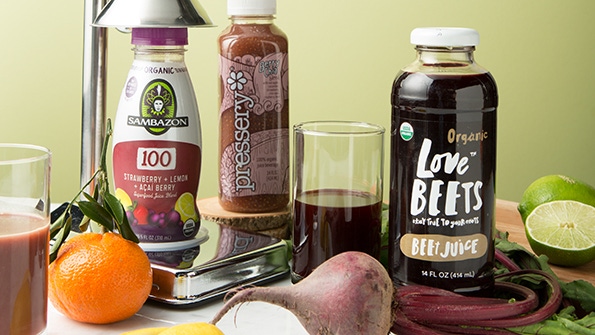
Orange juice: out; fruit and veggie juice blends: in
While the sweet morning staple lags in sales, blended juices are crushing it. In the natural channel, sales of refrigerated high-pressure processed (HPP), also called "cold-pressed" or "cold-pressure" juices and functional beverages grew impressively toward the end of 2014. But it's not just natural consumers who are slurping up these popular beverages. Mainstream shoppers are crazy for cold-pressed drinks, too.
But these juices can contain astronomical amounts of sugar. Yes, it's all from nutritious fruits like strawberries, bananas, apples and more, but some brands contain as much as 48 grams per 15 ounce bottle (typically two servings), more than a 12 ounce can of Coke, which delivers 39 grams. All that sugar and no fiber means high glycemic index. Smart brands are addressing juices' sweet overload in myriad ways.
Some juice companies offer retooled blends that contain more water, less sugary fruit or sugar substitutes such as organic stevia and erythritol to lower sugar content. Suja's Lavenade, for example, contains healthful ingredients including lemon, red cabbage, maqui berry powder, lavender flower and organic stevia—all for just 20 calories and 2 grams of sugar for the entire bottle. Likewise, Sambazon's USDA Organic 100 Superfood Juice blends antioxidant-rich acai berries with apple and lemon juices, strawberry and an organic stevia-erythritol blend.
Another way manufacturers are controlling sugar: fiber-rich add-ins such as chia seeds, nuts, flax and more to create "chewable"€ drinks. The idea, says Kevin Quirk, CEO of Harvest Soul, an HPP beverage brand that incorporates high-fiber and high-protein foods including golden berries, goji berries, almonds, pumpkin seeds and more into fruit and vegetable blends, is to force people to slow down and literally chew their juice. "When you're drinking, you're not chewing, which is the critical part of the digestive process,"€ Quirk says. "Here, you get a blended juice with perfectly sized seeds, nuts and berries—it's a complete-nutrition beverage. Though Harvest Soul contains naturally occurring sugar, "our product is low-glycemic due to all the fiber."
Other beverages, including the Boulder, Colorado-based Pressery and California-based Mamma Chia—arguably the pioneer in chewy drinks—incorporate chia seeds for added heft, satiety and regulated sugar absorption. One caveat: chia adopts a gel-like consistency when rehydrated, making for an acquired taste and texture.
Is it a fad?
Can we expect juice sales to continue on this upward trend? Beverage innovation will help drive the refrigerated juice category forward. High-pressure processing played an integral role in allowing fresh juice to step out of strictly made-to-order juice bars and into the convenient, grab-and-go refrigerated section. Using pressure rather than heat, supporters of HPP believe the technology better allows manufacturers to create a juice similar to what fans make at home while also addressing food safety issues. "While HPP doesn't give you dramatic shelf life, it does give you an extremely longer shelf life if you haven't pasteurized it at all,"€ explains Tim Avila, president of Systems Bioscience.
But HPP may not be the be-all and end-all of fresh juices. In 2014 Suja went through hot water with the Food and Drug Administration after calling their cold-pressed juices "fresh," a term defined as "has not been frozen or subjected to any form of thermal processing or any other form of preservation," according to the FDA. Some juice purists advocated that even though fruit and vegetable juice wasn't heated, high pressure destroys beneficial microorganisms along with harmful pathogens.
So is there an alternative to HPP? Possibly. While not yet used for finished juice products, new technology called dynamic cellular disruption (DCD) is on the horizon. DCD employs high speed to essentially disintegrate plants without using physical blades. All of the fiber and phytonutrients are still maintained, and dangerous bacteria are selectively eliminated. No commercial juice product currently uses DCD, but Avila believes this pasteurization approach is ripe for wide market appeal. "This technology will make fruits and vegetables into a really small microjuice," Avila continues. "The future is coming and this is a possible new angle for juice."€
About the Author(s)
You May Also Like
.png?width=700&auto=webp&quality=80&disable=upscale)




